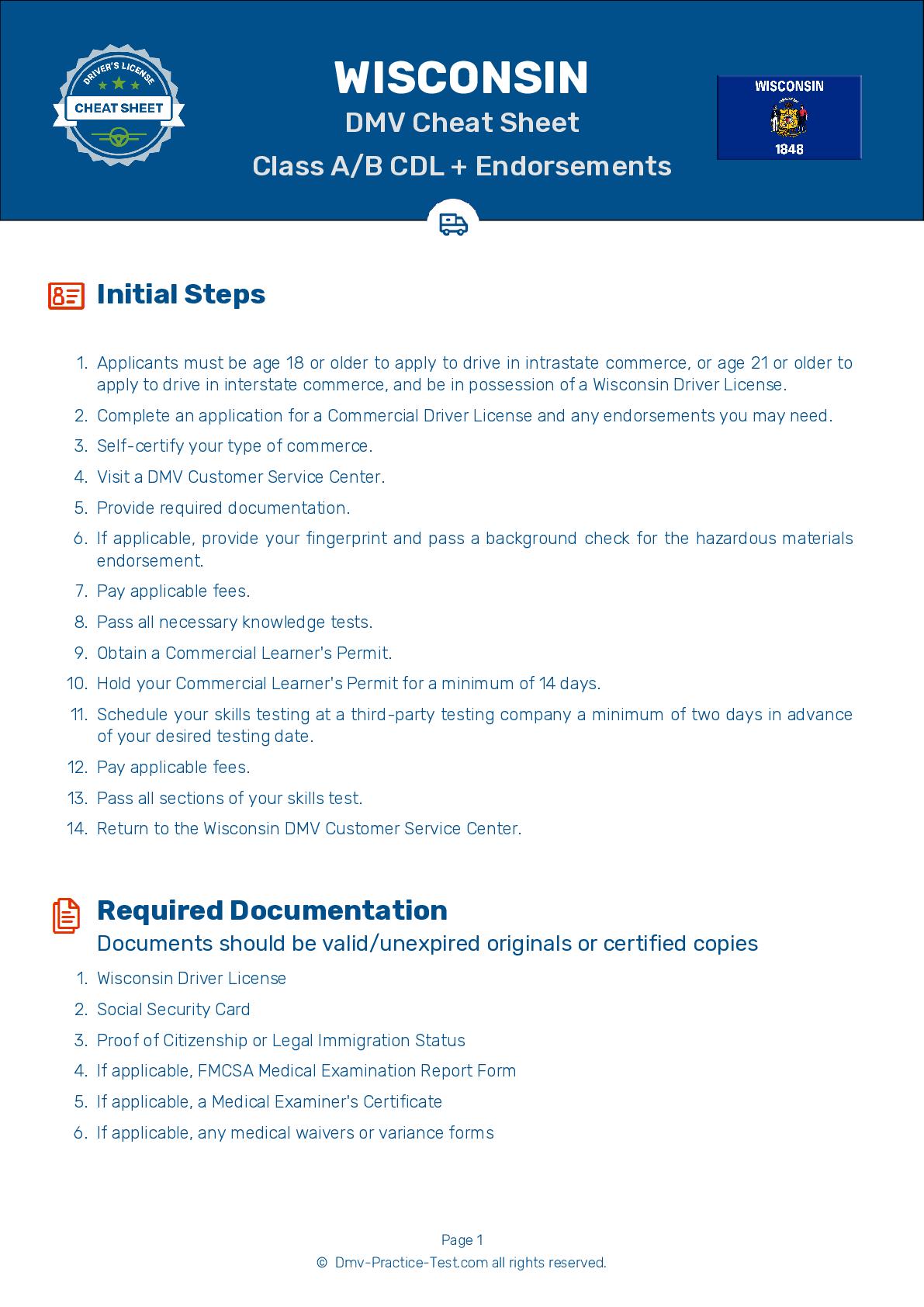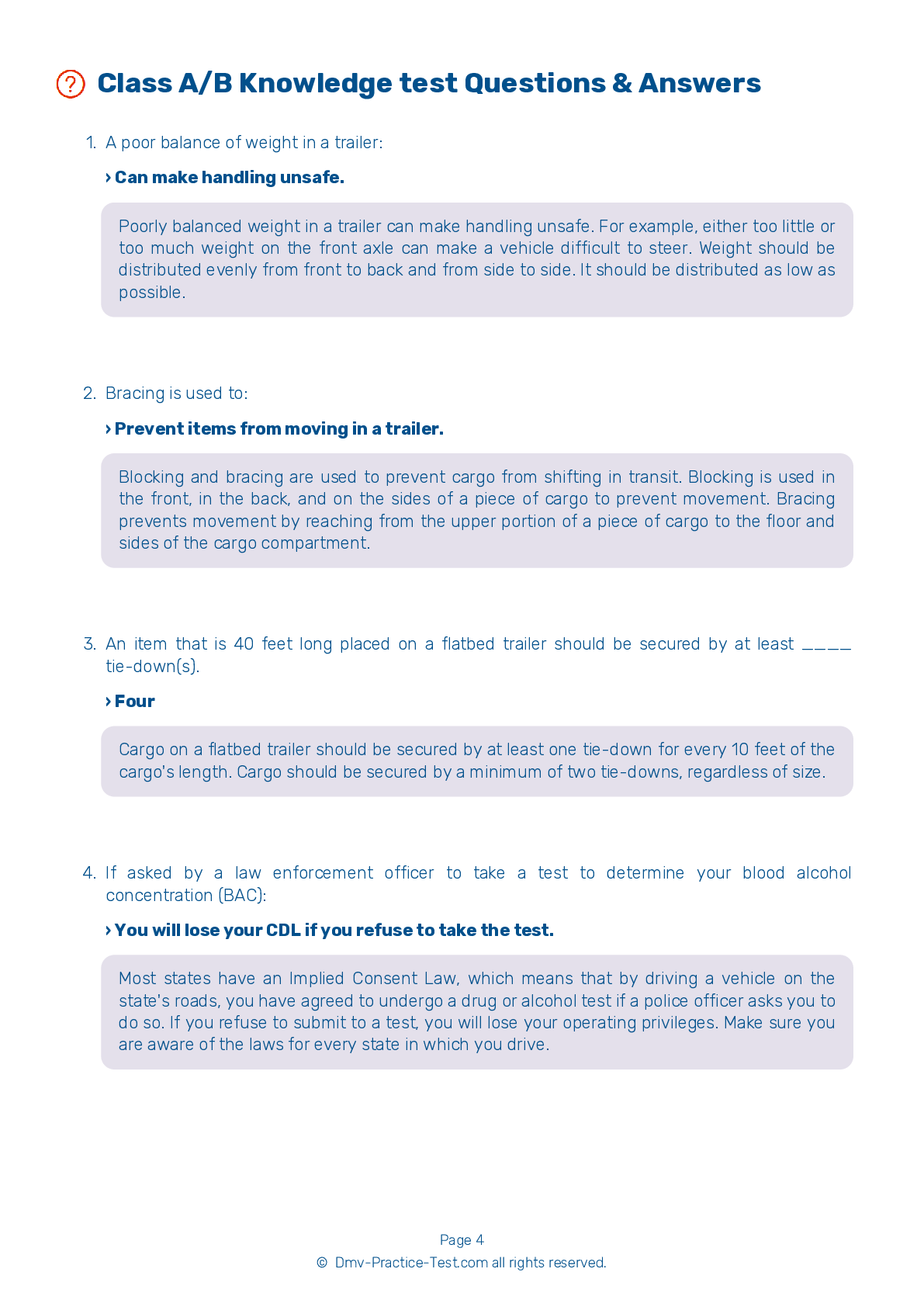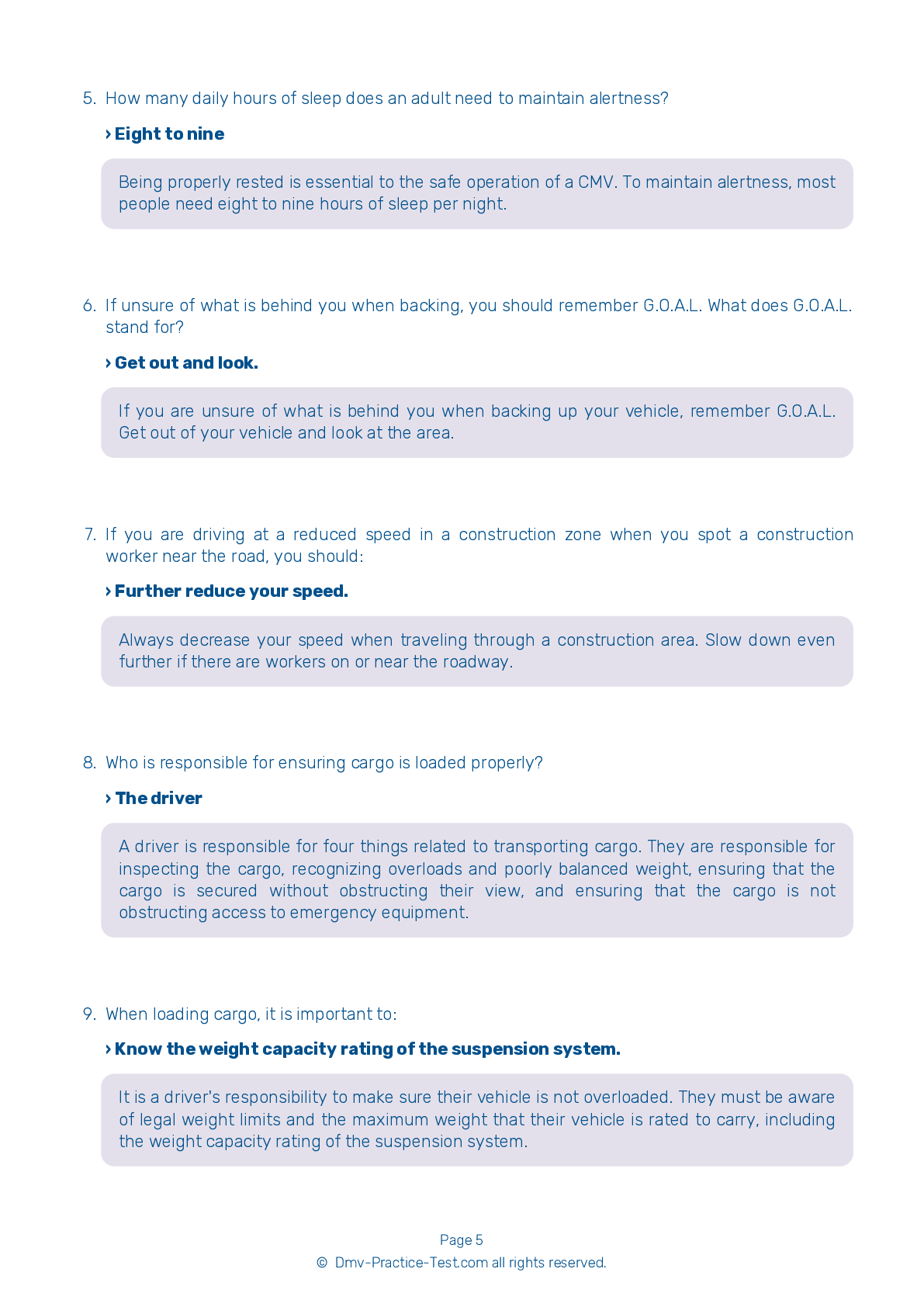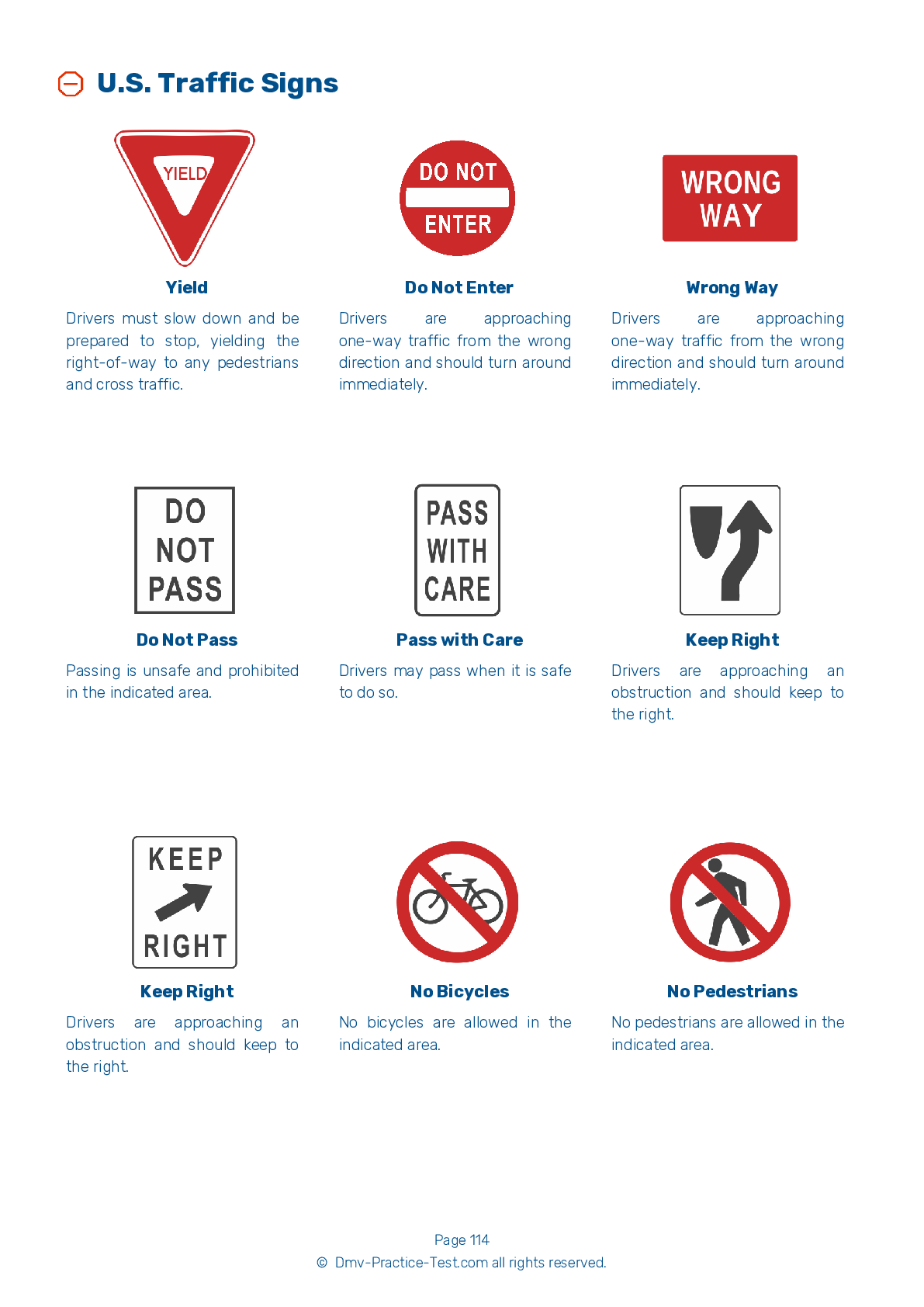Air Brakes #1
Air Brakes Endorsement Test | Wisconsin 2025 #1 Page 4 of 4
Train for FREE online with our Wisconsin CDL air brake test. The official exam test consists of several obligatory parts, with all of them checking your knowledge of different blocks of road rules. If you need to obtain a WI Class A/Class B driver license in 2025, practice as much as possible. Free sample tests published on our website will help you check and improve your knowledge and boost your grades. Please bear in mind that the requirements for CDL may vary from state to state.
25
20
20
19 . To ensure normal stopping power, drivers of vehicles equipped with a front brake limiting valve should:
Some older vehicles have front brake limiting valves with "normal" and "slippery" settings. Setting a brake limiting valve to "slippery" reduces the vehicle's stopping power, so a driver should make sure the valve is in its "normal" position. Front wheel braking has proven to be effective in all driving conditions.
20 . In a dual air brake system:
There are two air brake systems in a dual air brake system. The systems share a set of brake controls, but each system has its own tanks, hoses, and lines.
21 . Why do you need to drain air tanks regularly?
To remove bad air from the tanks
Compressed air in an air brake system usually contains a certain amount of water and compressor oil. The water and oil can damage the brakes if left to accumulate in the system. Tanks must be drained regularly to remove this build-up.
22 . A tank endorsement is:
Optional when transporting hazardous materials.
In general, a tank endorsement is required to a drive tank vehicle used to transport liquids or gases. This applies to both hazardous and non-hazardous materials.
23 . If the low pressure warning light comes on while you are driving:
You should continue driving, but turn the emergency flashers on to warn other motorists.
If the low air pressure warning light turns on, you should stop and safely park your vehicle as soon as possible. Controlled braking will be possible only as long as enough air remains in the tanks.
24 . Truck tractors with air brakes that were built on or after March 1, 1997 are equipped with:
Anti-Lock Braking Systems (ABS).
Truck tractors with air brakes that were manufactured on or after March 1, 1997 are required to be equipped with Anti-Lock Braking Systems (ABS). ABS is required in any other type of vehicle with air brakes that was manufactured on or after March 1, 1998.
25 . Braking mechanisms are located inside:
Drum brakes are attached to the wheels and located on the axles of a vehicle. The braking mechanisms that cause the vehicle to stop can be found inside of a drum brake.
2025 Wisconsin | Frequently Asked Questions
To acquire a CDL Hazmat endorsement in Wisconsin, you must hold a valid Commercial Driver's License (CDL). You'll also need to pass the Hazardous Materials Endorsement Knowledge Test, provide proof of U.S. citizenship or legal status, and pass a Transportation Security Administration (TSA) background check. Finally, you must pay all required fees.
To obtain a CDL Hazmat license in Wisconsin, you must first possess a valid CDL. You must also pass a written Hazardous Materials Endorsement Knowledge Test and a TSA background check. Additionally, you must be at least 21 years old and have no disqualifying criminal offenses. Renewal requires passing the knowledge test again every five years.
When applying for a CDL Hazmat endorsement in Wisconsin, you'll need to provide proof of U.S. citizenship or lawful permanent residency, such as a passport or birth certificate. You'll also need your current CDL, social security card, and completed application form. Finally, you must provide fingerprints for the TSA background check.
Yes, there is a dedicated written test for the CDL Hazmat endorsement. The Hazardous Materials Endorsement Knowledge Test focuses on topics such as loading and unloading hazardous materials, bulk packaging marking, driving and parking rules, and emergency response procedures. The test must be passed with a score of at least 80%.
The written test for the CDL Hazmat endorsement in Wisconsin covers topics such as loading and unloading hazardous materials, bulk tank loading, inspection, driving and parking rules, communications, emergencies, and the definitions of hazardous materials. It also tests knowledge of the Hazardous Materials Regulations of the federal Department of Transportation.
Yes, there are additional charges for getting a CDL Hazmat endorsement in Wisconsin. These include a knowledge test fee of $30, a fingerprinting fee of $86.50 for the TSA background check, and an endorsement fee of $10. There may also be additional service fees depending on the method of payment used.
Yes, a background check and security clearance are mandatory for a CDL Hazmat endorsement. The Transportation Security Administration (TSA) performs these checks. Applicants must not have any disqualifying criminal offenses, and must be a U.S. citizen or have appropriate immigration status. The process includes fingerprinting and a review of personal history.
Yes, specialized training or certification is required for a CDL Hazmat endorsement. Applicants must pass a written Hazardous Materials knowledge test. Additionally, they must undergo a Transportation Security Administration (TSA) background check. Also, they must comply with the Federal Motor Carrier Safety Administration's training requirements for hazardous materials.
No, you cannot legally transport hazardous materials without a valid CDL Hazmat endorsement in Wisconsin. This endorsement is required by the Federal Motor Carrier Safety Administration (FMCSA) for any commercial driver who transports hazardous materials that require placarding. Violations can lead to fines, disqualification, or even criminal penalties.
Yes, you can add the CDL Hazmat endorsement to your current CDL license. However, you'll need to pass the Hazmat knowledge test and undergo a TSA background check. You don't need to apply for a new CDL, but there is an additional process for obtaining the Hazmat endorsement. Visit your local DMV or its website for specific procedures.



